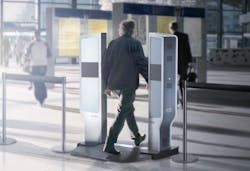Evolv Technology provides a new way forward in threat detection
When it comes to detecting firearms, explosives and other threats concealed on the human body, the tools available to security end-users are somewhat limited and come with their own set of drawbacks. The most popular option by far remains walk-through and hand-held metal detectors, which can be cheaply and easily deployed in a wide variety of applications; however, while metal detectors allow for relatively high throughput, their sole purview of detecting quantities of metal means that other threats – such as those posed by plastic explosives – could go unnoticed.
On the opposite end of the spectrum are millimeter-wave body scanners like those used by the Transportation Security Administration to screen travelers at the nation’s airports. While these machines enable screeners to detect a wider variety of threats, throughput is much slower, the price is significantly higher and people must deal with the additional hassle of removing everything from their pockets.
Evolv Technology believes it has found a happy medium between these two solutions. Founded in 2013 by industry veteran Mike Ellenbogen, who previously headed up CT baggage scanner maker Reveal Imaging, Evolv’s goal was to bring a different approach to soft target security.
“With the rise of al Qaida, ISIS and active shooters in the U.S., we wanted to design technology that could fit the needs of locations that have to move a lot of people very quickly and create a safe environment – not necessarily a sterile environment, but a safe environment to address today’s threats: explosives, firearms and related weapons,” explains Ellenbogen, who serves as Evolv’s CEO.
Similar to the TSA’s body scanners, the Evolv Edge solution combines millimeter-wave technology and a number of other sensors to non-intrusively screen people as they walk through the machine for threats. Unlike those airport body scanners that require people to enter, turn 90 degrees and put their arms in the air while columns scan the entirety of their body to create an image, the Edge system screens subjects as they walk between two columns and can produce an analysis of what someone may be carrying in about a hundredth of a second.
“We can effectively eliminate motion blur, so we can screen people as they are walking, and they can walk through with all of the things they would normally carry – backpack, briefcase or a purse. We can screen for firearms, explosives, suicide vests or belts as folks are entering at a rate of about 900 people per hour through one lane,” Ellenbogen says. “We all carry a cellphone, keys, wallet and belt buckle – all of the things that traditionally set off a traditional metal detector. Using a combination of smarter sensors with a lot of computing power allows the system to work very quickly. Using machine learning or AI, we can enable people to walk through quickly, smoothly, unobtrusively and provide an automated red light or green light decision but without creating another hassle or bottleneck.”
Threat Detection Integrated with Facial Recognition
Additionally, the company has added facial recognition as an available option through its Evolv Pinpoint solution, which can be used in conjunction with the Edge system as a mechanism for spotting people on watch lists or even as a means of access control.
“We have customers that use the system or want to use the system to create a completely unmanned checkpoint that includes a doorway, so as I walk up to it, it would recognize me as an employee, screen me, verify that I’m not carrying any kind of threat and then automatically open the door,” Ellenbogen says.
Traditional Challenges
Historically, one of the biggest challenges that stadiums, transit facilities and critical infrastructure sites have experienced in trying to use various threat detection technologies is that many of them just simply don’t work as intended. While a system may have been used with positive results in a university lab, Ellenbogen says real-world applications present variables that just cannot be tested for in a sterile environment.
“Most of the challenges aren’t things you think about until you are out dealing with the real world,” Ellenbogen adds. “Whether it is a machine looking for explosives in suitcases or something that is inspecting people, you can make all of the assumptions you want in your lab or ivory tower, but the technology is proven or not once it hits the field.”
Expanding the Market for Threat Detection
Evolv has screened more than one million people to date and the company already has a number of deployments in a variety of vertical markets, including stadiums, transit systems and even airports. From a cost perspective, Ellenbogen says the Evolve Edge system is about one-third the price of airport body scanners but certainly cost more than a typical metal detector. However, he insists they are not looking to replace current aviation checkpoint technology with the Edge system, explaining that TSA is looking for threats to aircraft rather than crowds or a venue – the target application for this product.
“We are looking at where to we go from here," Ellenbogen says. "There is a great need for higher throughput systems that create that safe environment – especially as we look at active shooters. A lot of venues that aren’t currently doing screening of any kind or deploying proactive security technology have made that decision because they associate screening with walk-through metal detectors or guards with hand wands. Helping people understand there are alternatives that can actually improve the visitor experience while, at the same time, improve your security posture is the message we need to broadcast more broadly.”
About the Author:
Joel Griffin is the Editor-in-Chief of SecurityInfoWatch.com and a veteran security journalist. You can reach him at [email protected].




